During the use of leather items, microscopic cracks and splits inevitably occur, creating vulnerable entry points for water, dirt, grime, grease, and sweat salt. These substances gradually infiltrate the leather, weakening and damaging its collagen and protein fibers. Over time, this can lead to irreparable cracks, splits, and overall deterioration. Additionally, exposure to heat can exacerbate the drying, cracking, and hardening process. However, with regular care and maintenance, these issues can be mitigated.
Properly maintaining leather ensures its functionality, suppleness, and overall condition for many years, while also preserving its value. It’s crucial to consider the type of finish used on the leather item, as it dictates the appropriate care routine. For instance, aniline leather is prone to staining, so caution should be exercised when using conditioners that contain dyes or oils, as they may permanently darken the leather’s appearance. Conversely, pigmented items are less absorbent, especially when new, so it is advisable to use conditioners sparingly but regularly.
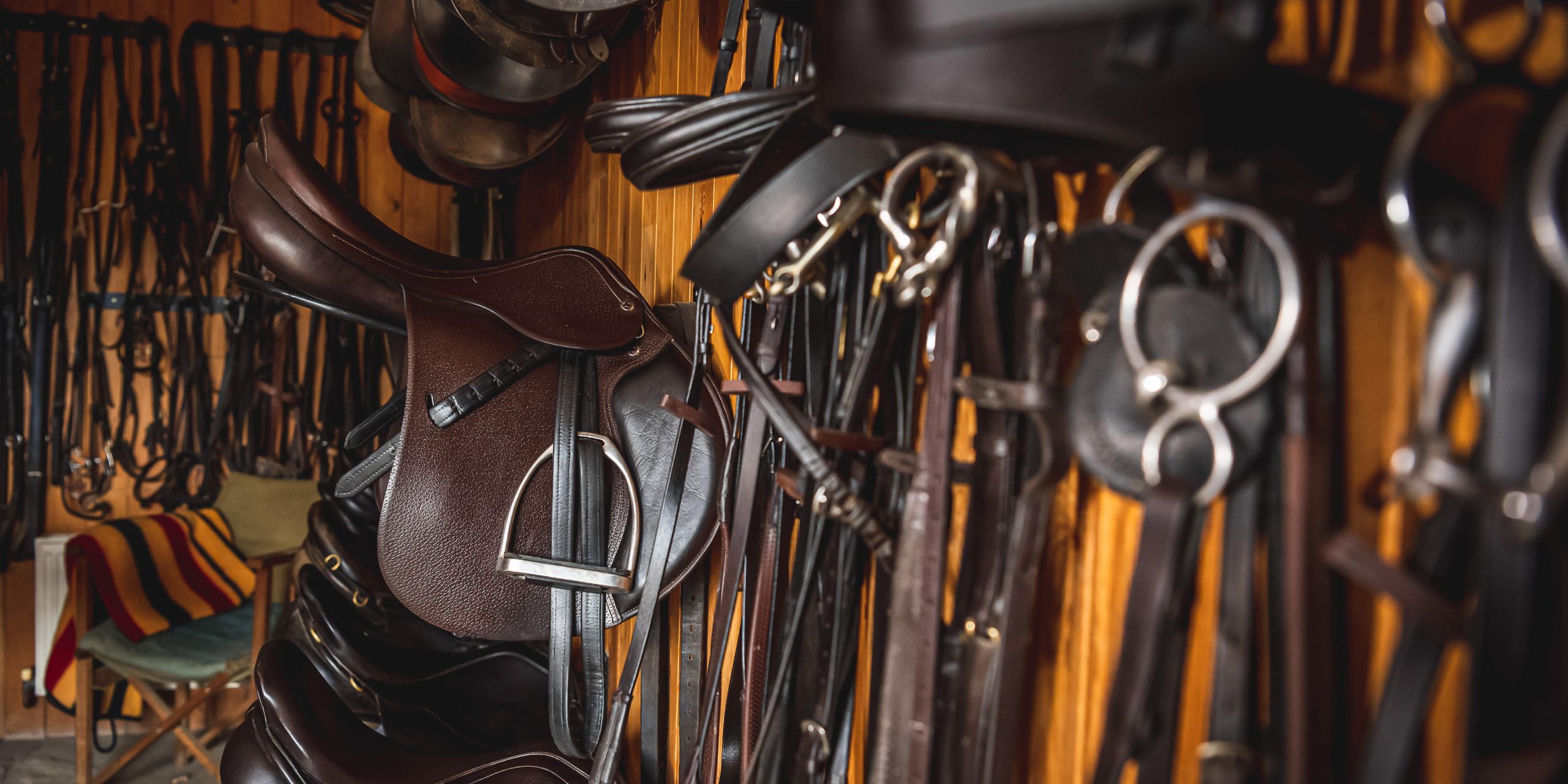
Daily Maintenance Clean
MAKE SURE IT’S CLEAN FIRST
For optimal care, it is recommended to wipe all saddlery items after use to eliminate the harmful salts present in sweat and grease. Additionally, a thorough cleaning should be conducted at least every fifth time the tack is used.
To achieve a comprehensive cleaning, it is advisable to disassemble the tack, if applicable, and clean each piece individually. This meticulous approach ensures that all components receive proper attention.
Similar to how you would shampoo your hair before applying conditioner, it is crucial to clean leather before applying a conditioner. This step guarantees that the leather’s surface is devoid of grease and dirt, allowing it to become porous and receptive to the conditioning product.
Belvoir® Tack Cleaner has been expertly formulated to swiftly and effortlessly eliminate grease and dirt from leather, all while avoiding excessive moisture that could potentially harm the stitching or saturate the leather. It’s important to note that an excess of liquid can lead to collagen fiber swelling, ultimately resulting in stretched and weakened leather.
The efficient drying process of Belvoir® Tack Cleaner ensures that it leaves no lingering moisture, preventing any potential damage to the leather structure. Furthermore, the product’s pH neutrality is carefully maintained to safeguard the integrity of the leather.
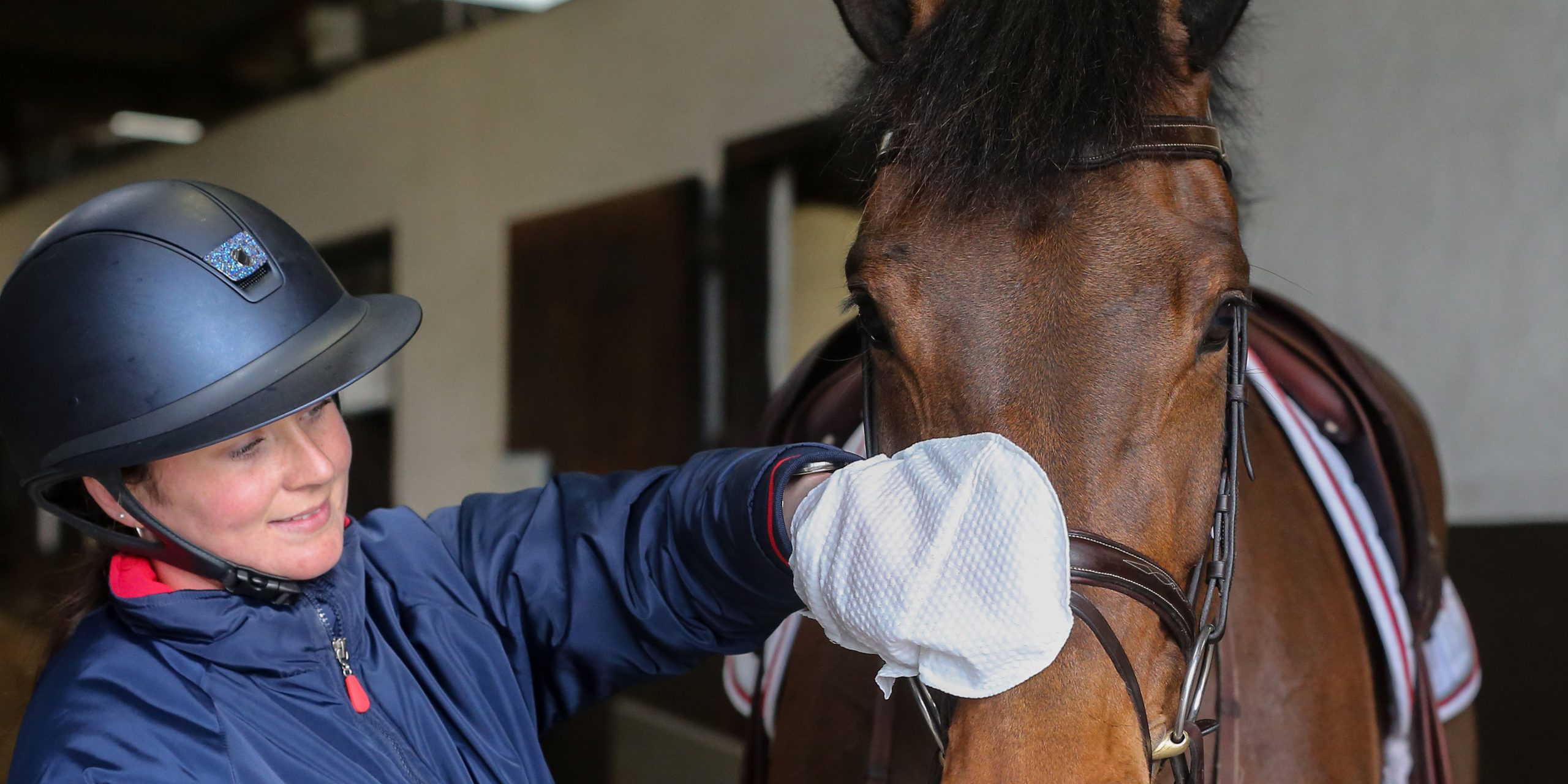

It is advisable to avoid using traditional Saddle Soap to clean and condition leather as it may not effectively remove grease and dirt. In fact, it has the potential to seal them in, leaving behind a greasy residue.
When dealing with muddy leather, it is essential to first carefully remove the mud, ensuring not to scratch the leather surface in the process.
Always remember to use a saddle cloth, as it serves to absorb sweat and grease while providing protection to your saddle.
Cleaning leather presents an excellent opportunity to conduct safety checks. Pay close attention to signs of wear and tear on billets, buckles, straps, and stitching. Any necessary repairs should be promptly addressed to prevent further damage and unnecessary expenses, ultimately ensuring your safety while using the equipment.
Then condition…
YOU HAVE THREE CONDITIONING OPTIONS …
After the leather has undergone a thorough cleaning and been given sufficient time to dry, you may notice a slight lightening of its color and a parched appearance. At this stage, it is essential to apply a conditioner to moisturize, protect, and maintain the suppleness of the leather.
Option-A
Belvoir® Tack Conditioner Spray is a glycerine-based soap specifically designed to provide a shiny and protective finish to leather. This unique formulation nourishes the leather while also filling and sealing its pores. By doing so, it creates a barrier against salt, dirt, grease, and water, effectively safeguarding the leather’s integrity. When using the conditioner on new leather, it is important to exercise caution and avoid over-application, as excessive use may lead to the formation of a tacky film on the surface. Belvoir Tack Conditioner is available in both spray and traditional solid bar forms to cater to individual preferences.
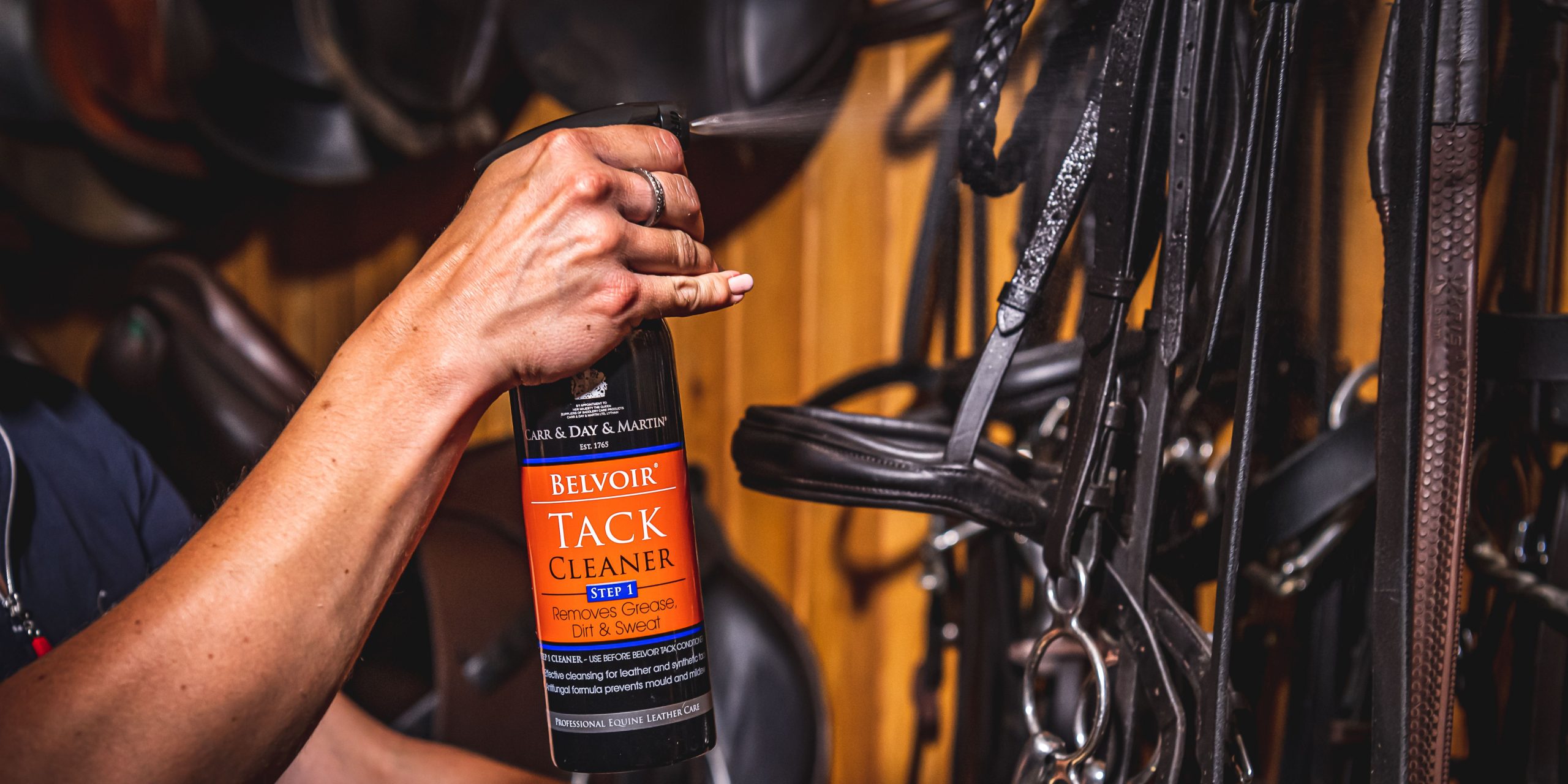
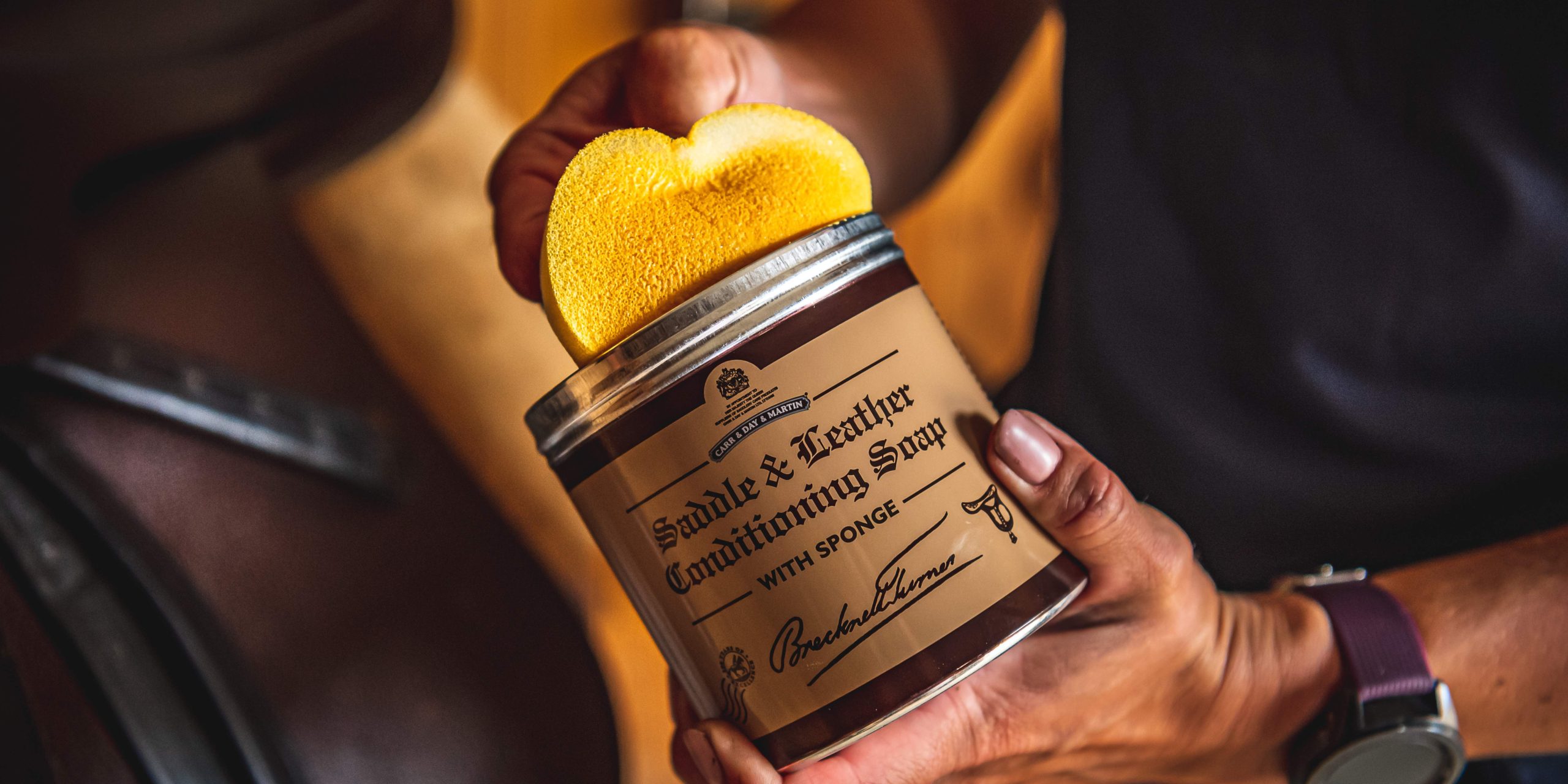
Option-B
Experience the benefits of Brecknell Turner Conditioning Saddle Soap, a delicately blended soap with a slightly thicker consistency. Unlike glycerine-based products that impart a glossy finish, this saddle soap offers a highly desirable matte finish, making it ideal for the show ring. While it does not possess the protective properties of glycerine, it provides effective conditioning for your leather items. The soap comes with a convenient sponge for easy application and usage. Enjoy the matt finish and conditioning benefits of Brecknell Turner Conditioning Saddle Soap, perfect for achieving a stunning appearance in the show ring.
Option-C
Enriched with lanolin and beeswax, Belvoir® Leather Balsam is a nourishing conditioner specially formulated to feed and condition leather. Its soft wax formula effectively provides a light oiling action that keeps the leather supple. This balsam is particularly effective when used in conjunction with replenishing oils, making it an excellent choice for new leather and finer items. To ensure optimal results, it is important to avoid over-application, just as with oils. The product includes a convenient sponge for easy and precise application. Prior to full use, it is always recommended to perform a compatibility test on a small area of the leather.
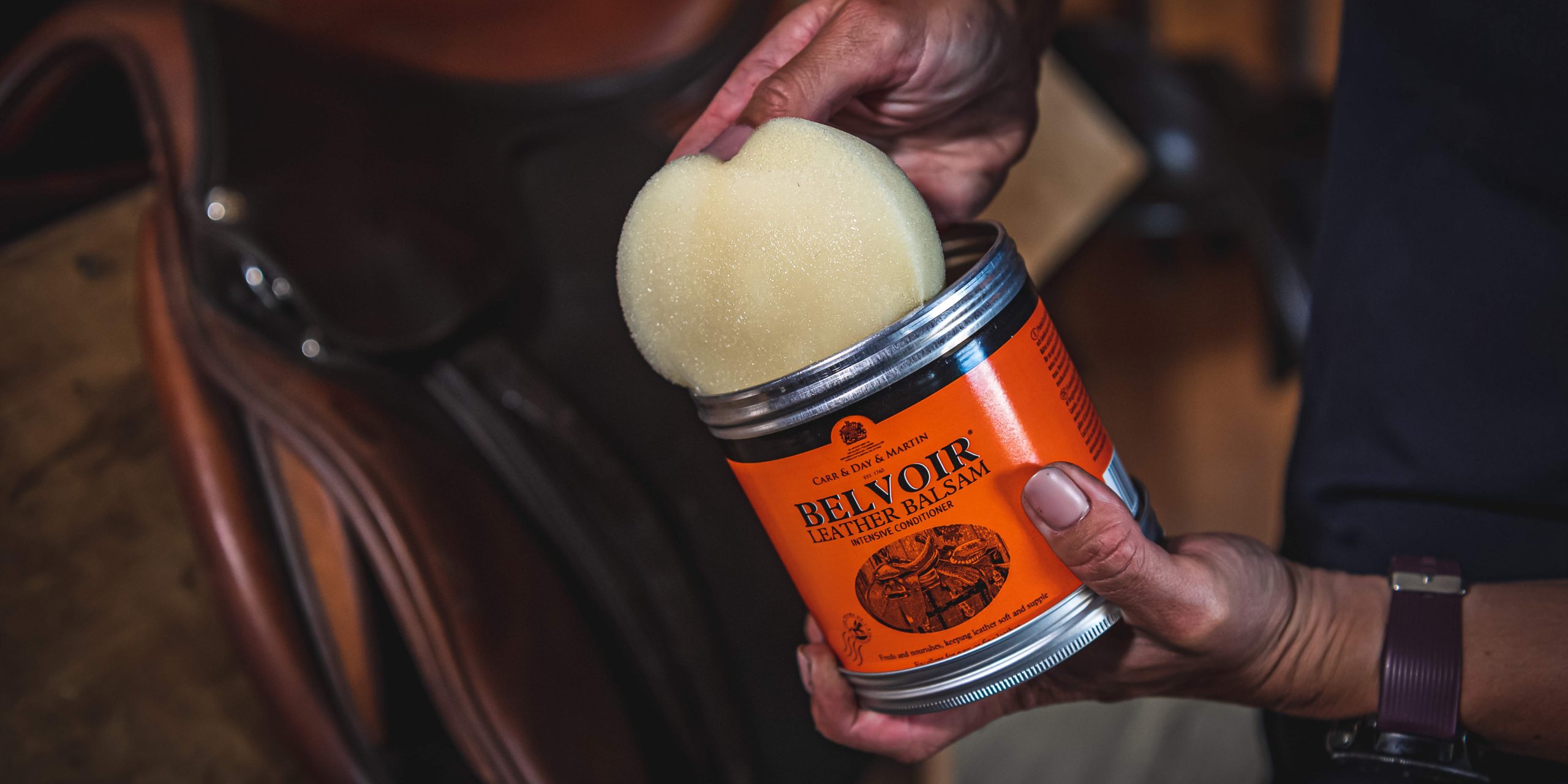
New Leather
When investing in a new saddle or bridle, it is crucial to prioritize their care right from the beginning. New leather items often have a stiff texture and can greatly benefit from a gentle oiling before initial use.
NEATSFOOT COMPOUND
As a general guideline, it is recommended to apply a thin layer of Neatsfoot Compound to the grain of the leather, and two thin layers to the underside or flesh. This process can be repeated whenever the leather feels dry or stiff.
When oiling stirrup leathers, it is advised to apply the oil very lightly, as overly supple leathers can stretch more easily.
Keep in mind that some items may come pre-oiled and ready to use, while others may have a protective layer that can be removed through cleaning before applying the treatment mentioned above.
After a short period of use, new leather will naturally soften and become more flexible. At this stage, minor fitting adjustments may be necessary.
Before applying any treatment, it is crucial to check the type of leather used in your saddle or bridle and how it has been finished. This will ensure the appropriate treatment and care for the specific leather type.
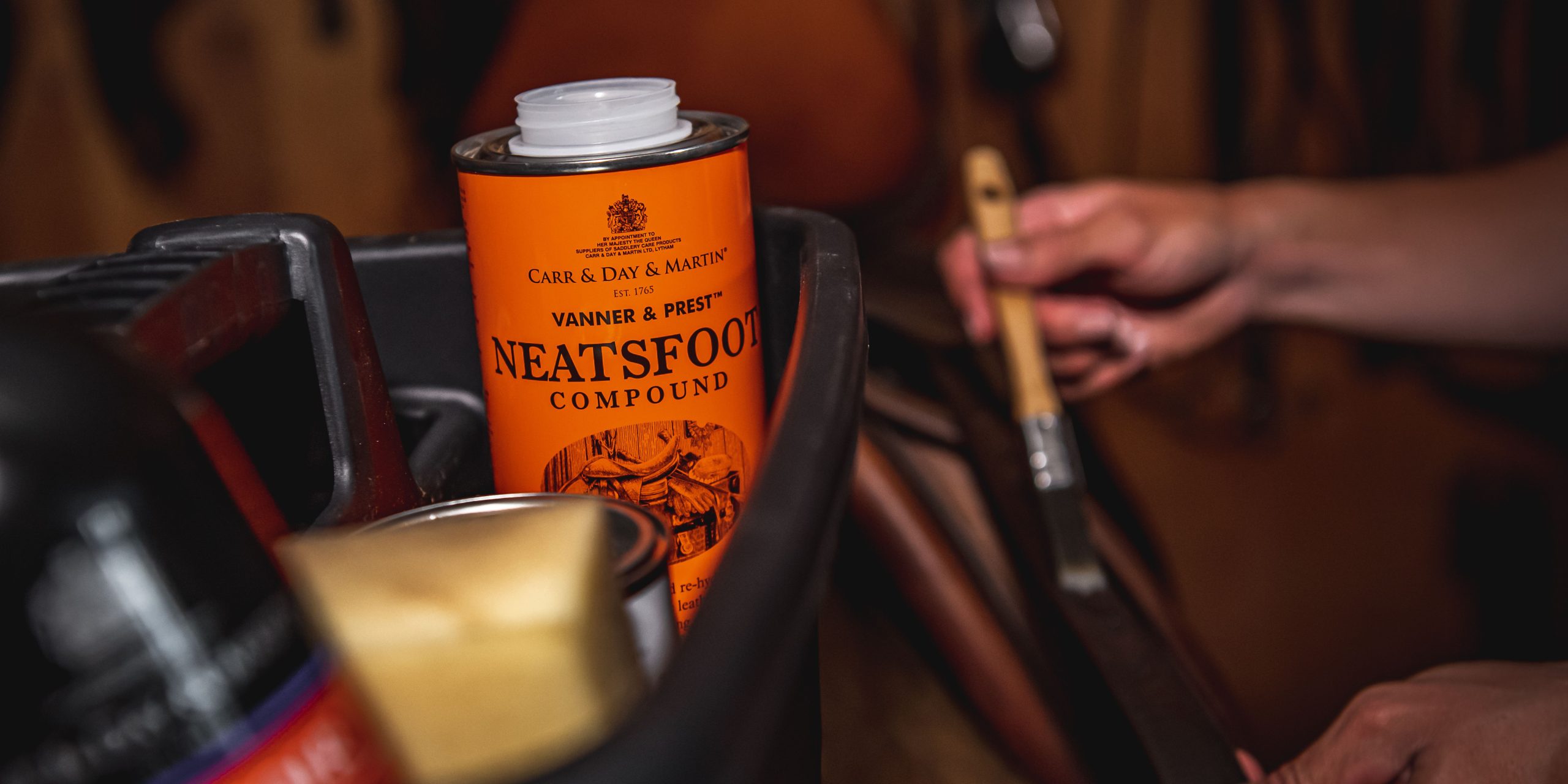
Caring for Saturated Leather
Prevention is better than a cure!
To minimize potential damage, it is advisable to avoid getting your tack wet whenever possible, as water can severely harm the delicate fiber sub-structure of leather. However, if your saddle or bridle does become soaked, proper care can help mitigate the consequences.
When leather becomes waterlogged, the inner fibers stretch to accommodate the absorbed water. This results in the weakening of the leather as the fibers become distorted from their normal strong organization.
As the leather dries, the conditioning oils evaporate along with the moisture, leaving the fibers with minimal lubrication. Consequently, they stick together in clumps, leaving the leather feeling stiff and dry. To counteract this, it is crucial to lightly condition the leather while it is still wet, as it remains permeable and responsive.
Always make sure to carefully wipe off dirt and mud before it has a chance to dry. Following this, it is recommended to use Belvoir Leather Balsam or apply Neatsfoot Compound sparingly.
When drying wet leather items, it is essential to allow them to air dry naturally and avoid direct heat sources like radiators, heaters, or fires. Rapid drying can lead to the quick removal of moisture and conditioning oils.
By following these steps, you can help prevent your tack from becoming stiff, dry, or watermarked. Additionally, investing in a waterproof saddle cover can help protect your tack from getting wet in the first place. Exercise caution in the rain, as color from waterproof jackets or chaps may run onto the saddle, and leather is more susceptible to staining when saturated.
Revitalising Dry & Cracked Leather
Leather naturally contains moisturizing and lubricating oils that are added during the tanning process. Over time, these oils are gradually lost as the leather is used, leading to a decrease in plumpness and flexibility.
As the leather fibers lose their moisture, they become thinner and more rigid. Instead of flexing and stretching as intended, the fibers become tight and stiff. This can be compared to repeatedly bending a piece of metal, which eventually weakens and results in cracks.
To address this issue, using an oil-based product like Neatsfoot Compound can revitalize the leather fibers, allowing them to move freely once again. Just as oiling an engine keeps it running smoothly, applying Neatsfoot Compound to leather helps restore its strength, reduces brittleness, and minimizes the likelihood of snapping.
As a general guideline, apply one or two thin layers of Neatsfoot Compound to the absorbent flesh side of the leather. This treatment helps strengthen the leather, making it less brittle and more resilient.
Carrs Leather Oil is recommended.
To use, apply a thin coating of the oil to the flesh side of the leather and allow it to soak in for a minimum of 24 hours. In cases where the tack is particularly dry, an additional thin coating can be applied to the grain side to help restore the color as well.
If the leather still appears dry after the initial application, another round of oiling may be necessary. However, it is important to avoid over-oiling and to wipe off any excess oil as it cannot be removed once absorbed.
Applying an excessive amount of oil can “collapse” the structure of the leather, leaving it with a slick and oily feel. Therefore, it is more effective to apply small amounts of oil regularly rather than a thick application all at once.
While cracks in leather cannot be repaired, their appearance can be minimized by consistent oiling and conditioning.

Treating Mould and Mildew
Mould and mildew thrive in warm, dark, and damp conditions, penetrating deep into the leather fibers, potentially causing permanent damage and weakening. It is crucial to be aware that if leather is poorly stored, mould and mildew can spread rapidly.
If any leather item becomes affected by mould or mildew, it should be promptly removed from the tack room to prevent the spores from spreading to other saddlery items. Using a Belvoir Tack Cleaner Mitt, carefully wipe away the mould and mildew, ensuring proper disposal of the mitt to prevent further contamination.
Subsequently, clean the affected area with Belvoir Tack Cleaner Spray to help prevent the regrowth of mould and mildew. For stitching and hard-to-reach places, an old toothbrush can be used for thorough cleaning. Follow up with conditioning as usual. It is important to note that if a saddle has been significantly affected by mould and mildew, some staining or mottling may persist. While it cannot be completely removed, with proper care, it may gradually fade over time.
Since mould and mildew can deeply penetrate the leather, complete removal is impossible. However, taking the correct preventative measures can keep the spores dormant. Maintain a dry and well-lit tack room, considering the use of low-level storage heating or a dehumidifier. Additionally, make it a habit to wipe your tack daily with Belvoir Tack Cleaner Mitt. Remember to remove any damp saddle cloths, numnahs, and girths, allowing them to dry away from the tack area.
Storage
To ensure the longevity and integrity of leather, proper storage conditions are crucial.
The tack room should be kept dry and at a consistent room temperature, with good ventilation for optimal air circulation. It is important to avoid high temperatures as they can draw out the protective oils and moisture from the leather. Additionally, leather should be protected from direct sunlight and fluorescent light, as these can cause premature aging and fading.
When storing tack, it is recommended to keep it off the ground. Saddle racks should be used to support saddles and preserve their shape.
Using a saddle cover is beneficial to protect tack from dust, debris, and accidental scratches. However, it is important to avoid plastic or waterproof covers as they can create a moist environment that attracts mold. Instead, opt for a breathable saddle cover made of cotton or other suitable materials.
If tack is not going to be used for an extended period, it should be carefully stored to maintain its condition. Leather straps, such as bridles and leathers, are best stored flat and should be taken apart and stored unbuckled to prevent unnecessary strain and damage.
Before storing, it is important to thoroughly clean the leather items, but refrain from conditioning them.
Once the leather is completely dry, apply a protective layer of KO-CHO-LINE on both sides of the leather. This barrier will safeguard the leather from moisture, heat, and mold. Remember to also coat the buckles to help prevent rust.
After applying KO-CHO-LINE, wrap the items in cotton fabric, such as an old pillowcase, and store them in a suitable area, such as the tack room.
Periodically check the items in storage to ensure they remain in good condition and to address any potential issues promptly.
When you need to use the item again, carefully remove the protective grease with a cloth, then proceed with the regular cleaning and conditioning process as usual.
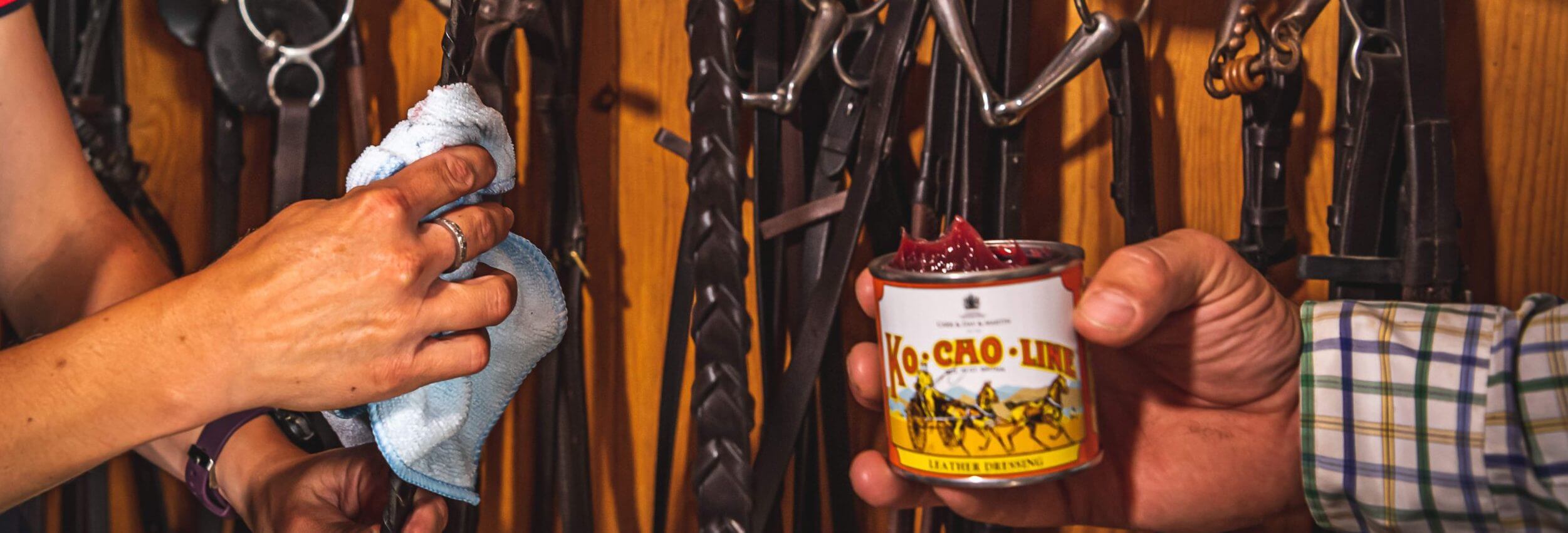
Keep it simple
So, now you know all you need to know about caring for leather – we hope we’ve made it easy to understand? If you’re still unsure or concerned, either call or email us.
There are 7 key things to remember:
- Determine the type of leather used in your tack and follow the specific guidelines provided by the manufacturer.
- Review any guarantees or warranties associated with the product.
- Use oil sparingly when revitalizing dry and cracked leather. Apply a small amount, allow it to absorb, and repeat as necessary. Excessive oiling can lead to irreparable damage.
- Storage conditions need careful consideration to avoid mould and mildew.
- Don’t dry saturated leather next to direct heat source. Clean and condition while wet, then leave to dry naturally.
- Maintain discipline in cleaning your tack after every ride to remove grease and sweat. Regular cleaning prevents the buildup of grime and makes weekly tack cleaning much easier.
- Disassemble your tack and thoroughly clean it at least every fifth time it is used. This ensures that all dirt and grease are removed from hard-to-reach areas. After cleaning, apply a conditioner to protect the leather and maintain its softness and suppleness.
Saddles and bridles represent a big investment and are an essential piece of kit. Look after them and they will keep their value and last for years.
Caring for your tack doesn’t have to be time consuming, we’ve made it quick and easy with our Cleaner and Conditioner; is there any excuse for dirty tack?
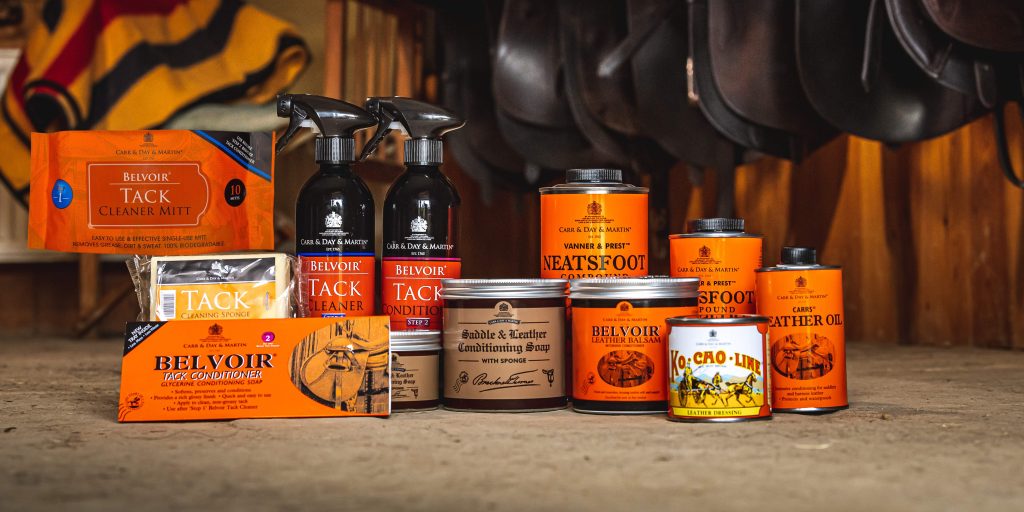
View our full Leather Care range

